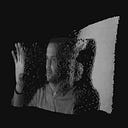Member-only story
Apple Vision Pro Perception Analysis
10 min readJun 11, 2023
The Apple Vision Pro device is equipped with multiple sensors to enhance its depth perception capabilities and create a seamless virtual and real experience in three-dimensional space. The visual sensors included are RGB camera, infrared camera, dToF LiDAR, structured light camera, and fisheye infrared camera.
The exterior of the Apple Vision Pro features:
- 2 forward-facing RGB cameras for forward shooting and VST (Virtual Spatial Tracking).
- 4 fisheye infrared cameras facing side and forward for 6DOF (Six Degrees of Freedom) tracking.
- 2 downward-facing infrared cameras for torso tracking and gesture tracking below.
- 2 infrared lasers that emit infrared light to illuminate the torso, legs, knees, hands, and the surrounding area within the control range, assisting the infrared and fisheye infrared cameras in capturing active elements in those areas.
- 1 dToF LiDAR laser radar, similar to the one used in the rear camera of iPhone Pro, supporting 3D shooting, spatial reconstruction, depth perception, and positioning.
- 1 structured light camera, also known as a TrueDepth…
